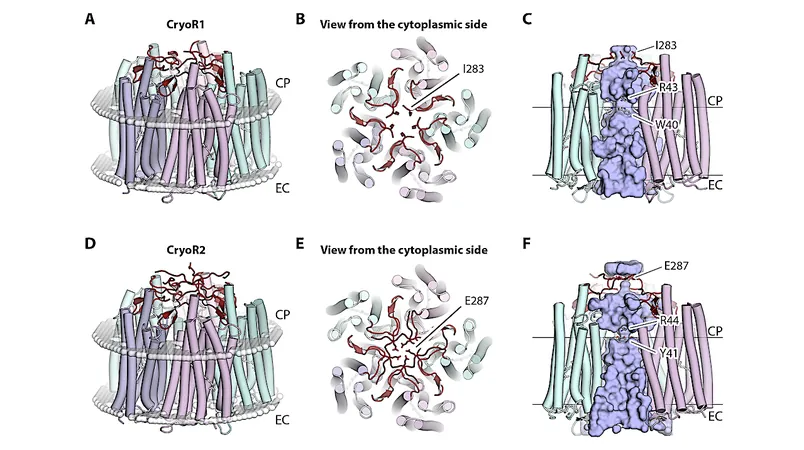
Unlocking the Secrets of Cryorhodopsins: The Ice World Proteins That Could Transform Neuroscience
2025-07-06
Author: Wei
Picture the breathtaking landscapes of Greenland's glaciers, the unyielding snow blanket of the Tibetan plateau, and the icy depths of Finland's groundwater. While these extreme environments captivate the eye, they also harbor astonishing proteins that could revolutionize how we understand and manipulate brain activity.
Enter Kirill Kovalev, an EIPOD Postdoctoral Fellow at EMBL Hamburg, who is diving deep into the realm of rhodopsins—colorful proteins that enable microorganisms to convert sunlight into energy. Kovalev’s quest is not just academic; he believes these mysterious proteins could hold the key to controlling the electrical signals in brain cells.
Meet the Cryorhodopsins: Nature's Electrical Switches
Among the myriad rhodopsins, cryorhodopsins have emerged as stars of Kovalev’s research. Found in cold-loving microorganisms, these proteins can seemingly control cellular activity like an electrical switch. Traditionally, rhodopsins have been harnessed in optogenetics, a method that neuroscientists use to manipulate neuronal activity with light.
Kovalev stumbled upon a new group of cryorhodopsins by chance while exploring protein databases. To his astonishment, these rhodopsins, thriving in frigid environments, bore striking similarities despite evolving continents apart. He aptly dubbed them 'cryorhodopsins'—a term that encapsulates their icy habitat.
A Kaleidoscope of Colors – The Key to Understanding Function
The captivating colors of rhodopsins play a critical role in their function. Most rhodopsins are shades of pink and orange, vigilant to absorb green and blue light to activate. Speedy blue variants are particularly intriguing due to their response to red light, which penetrates tissues more effectively.
Kovalev's laboratory investigations revealed unexpected color diversity among cryorhodopsins, including blue variants. He discovered that a specific structural feature present in these new proteins was the secret behind their vibrant hues. "By simply observing the color of a cryorhodopsin, I could assess what was happening inside," he noted with a chuckle.
Potential Game-Changer for Optogenetics
Kovalev’s collaborators moved ahead to test cryorhodopsins in cultured brain cells. When exposed to UV light, these proteins ignited electric currents, and intriguingly, further exposure to green light heightened cell excitability, while UV/red light diminished it.
The immense potential of cryorhodopsins is not lost on experts like Tobias Moser from the University Medical Center Göttingen. He envisions these proteins as pivotal in advancing optical cochlear implants, which aim to restore hearing through optogenetic methods.
Decoding a Dual Function: UV Light Detection in Cold Microbes
Excitement doesn't end there. Kovalev and his team also discovered that cryorhodopsins can sense UV light—a unique ability among their peers. This remarkable finding points to their role as 'photosensors' that allow cold-adapted microbes to detect potentially harmful UV radiation.
Kovalev speculates that cryorhodopsins evolved not just to survive in cold environments but primarily to protect microbes from intense UV exposure, thus providing a fascinating glimpse into the evolutionary pressures faced in these chilling habitats.
Scientific Expeditions: The Gateway to Discovery
The path to understanding these extraordinary molecules mandates expeditions to remote icy landscapes, enabling scientists to unveil microbial adaptations that might otherwise go unnoticed. Kovalev emphasizes the importance of such explorations in broadened scientific perspectives.
Technical Challenges and Triumphs in Cryorhodopsin Research
Characterizing cryorhodopsins posed significant challenges given their nearly identical structures. Slight variations can lead to vastly different properties, necessitating advanced experimental techniques. Kovalev employed a cutting-edge 4D structural biology approach, integrating X-ray crystallography and cryo-electron microscopy to decode these proteins.
Moreover, the exquisite sensitivity of cryorhodopsins to light required their analysis to be conducted in near-total darkness, showcasing the ingenuity and perseverance embodied in Kovalev's research.
Looking Ahead: The Future of Cryorhodopsins
Although cryorhodopsins are still in their infancy regarding practical applications, their potential design as tailored optogenetic tools appears bright. With these compelling discoveries, Kovalev is poised to lead a revolution in neuroscience, where the power of light could illuminate the mysteries of the mind.





 Brasil (PT)
Brasil (PT)
 Canada (EN)
Canada (EN)
 Chile (ES)
Chile (ES)
 Česko (CS)
Česko (CS)
 대한민국 (KO)
대한민국 (KO)
 España (ES)
España (ES)
 France (FR)
France (FR)
 Hong Kong (EN)
Hong Kong (EN)
 Italia (IT)
Italia (IT)
 日本 (JA)
日本 (JA)
 Magyarország (HU)
Magyarország (HU)
 Norge (NO)
Norge (NO)
 Polska (PL)
Polska (PL)
 Schweiz (DE)
Schweiz (DE)
 Singapore (EN)
Singapore (EN)
 Sverige (SV)
Sverige (SV)
 Suomi (FI)
Suomi (FI)
 Türkiye (TR)
Türkiye (TR)
 الإمارات العربية المتحدة (AR)
الإمارات العربية المتحدة (AR)